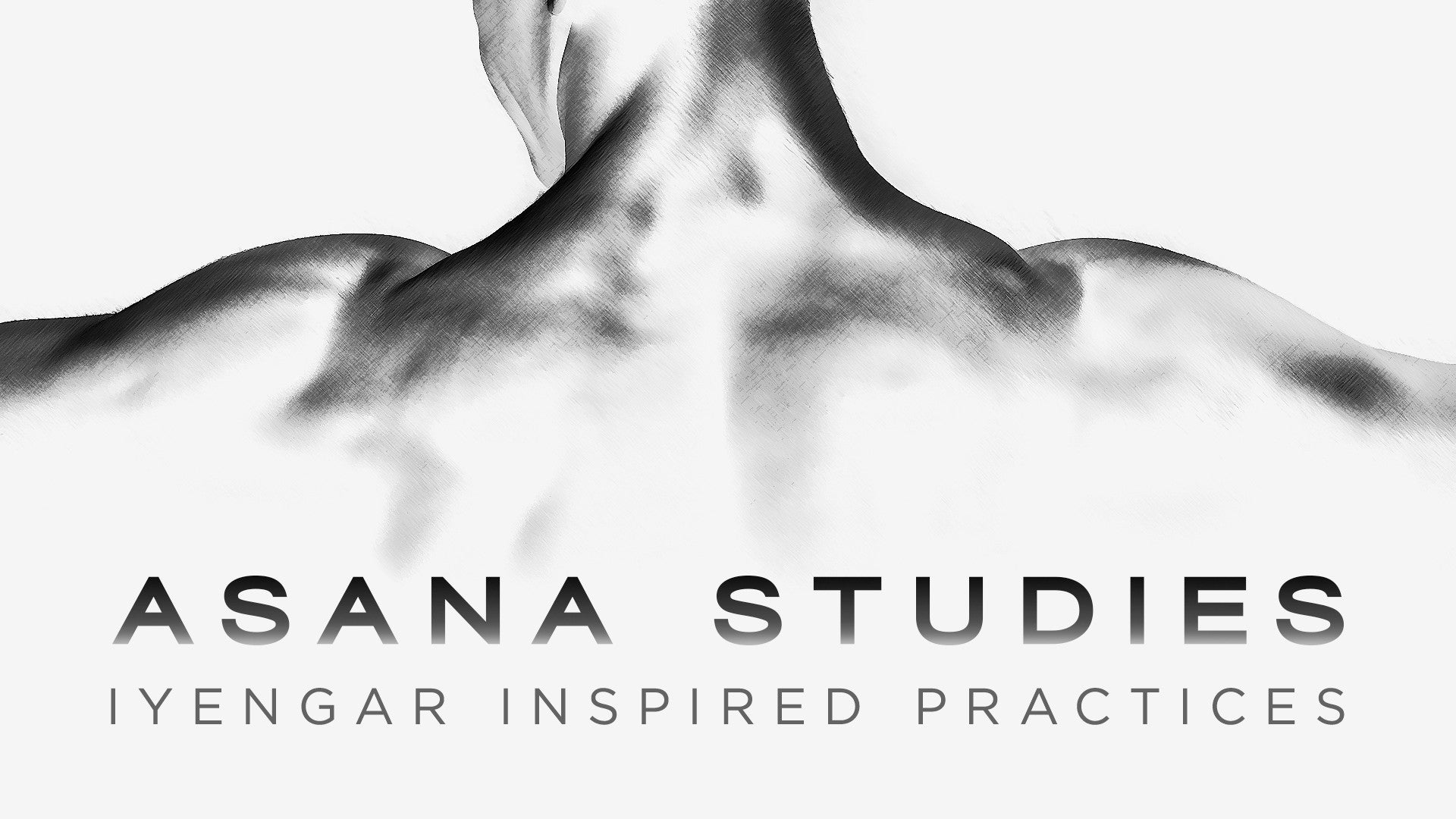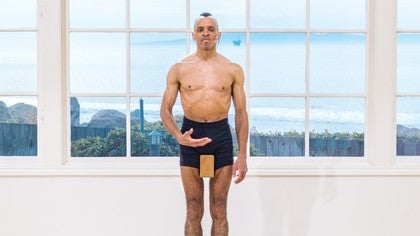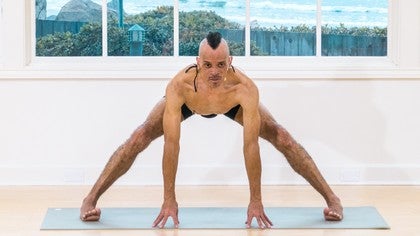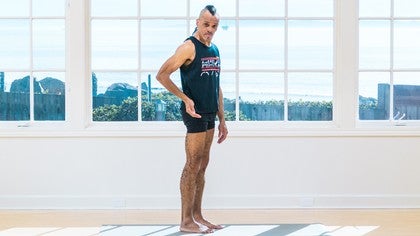Description
About This Video
Transcript
Read Full Transcript
Block tadasana. So using the block gives an opportunity to practice act of tadasana, the foot and leg shaping actions, in a way that the block, becomes a frame, in which the accent of the feet and legs, are more put into balance, in relationship to each other, for the purposes that we're using them. So when we step to the mat, we're not gonna look, we'll look at the general vicinity okay, we take the block, we take the feet wide, now we'll do the first set with the left hand forward, we shape the feet, we hold the block like this, the reason we hold the block like this, is because we want to get the best quality of lift, from pulling the block into the pelvic floor as possible. Doing this gives not the same quality of lift, we hold the block like so, we put the block shaping the feet, that means we lift the toes up and spread them wide, very active with the feet, now with the feet wide, pull the block firm against the pelvic floor, we want the block to be as much forward as it is back, make sure it's not too far forward and not too far back, we pull the block firm into the pelvic floor, and then we step the feet together, holding the block there, I continue to actively hold the block firm into the pelvic floor, and I'm shaping the feet, now once the legs are straight, once the legs are straight, and not before, but when the legs are straight, I let the block go. The reason you wanna hold the block there, until the legs are straight, is because we wanna get the most possible firmness of the block into the pelvic floor as possible, when we let the block go it's going to slip down a little bit, now the idea here is not to squeeze the block, so don't worry about squeezing the block, it'll stay there, now with the block where it is, we put the feet as close as they can be, without the knees or feet touching, whichever happens first with the shape of your legs, and then we begin to do the foot and leg shaping actions, shape the feet, not looking at it, down the back of the legs, through the heels, standing upright, use the weight in the heels to move the top of the thigh bones below the buttocks, back to the wall behind you, scruff the heels apart, lift the outer arches, and spin the knees out, so it's down the back legs through the heels, standing upright, moving the top of the thigh bones back, scruffing the heels, lifting the outer arches and spinning the knees out, now when you've done those actions, the foot and leg shaping actions, layered them and blended them, and from feeling how you think they are, you can look to see the alignment of the feet, how they are, you can look to see if they're lined up the way you think they are, if not adjust them, and then look up again, and reference the second feeling after you've looked, so we keep going down the back legs, through the heels, standing upright, using the heels and the floor, the weight in the heels and the floor, to move the top of the thighbone to the buttocks, back to the wall behind you, scruff the heels apart, the heel skin sticks, and the heel bones within the heel skin sticking on the floor, slide away from each other, press the heels to lift the outer arches, and spin the knees out, we keep doing that, down the back legs, through the heels, standing upright, scruff the heels, lift the outer arches and spin the knees out, and then we begin to change levels, now don't think of lowering, think of actually rising, as you change levels, so as I change levels, I keep the lift in my upper back as I change levels, soon as the hips flex the knees bend a little bit from changing levels, I'll take the block out, I'll let the block go, the upper body is completely passive, this is legs and spine, by the way root chakra muladhara, just legs and spine, I'm going as deep into utkatasana as I can come out of, now the reason go as easy as you can come out of, is because I've had some students go down so far, they can't get back up out, so go as deep as you know you can come out of, in utkatasana the arms are passive, I'm still scruffing the heels, lifting the outer arches and spinning the knees out, so this is still going on in a very subtle way in the legs, scruffing the heels, lifting out arches, spinning the knees out, remember when you spin the knees out, the heels still go apart, they don't come together, and then close the eyes, keep it going, keep the eye sight line lifted, with the eyelids closed, and then on exhalation when the belly hollows, I'll let my chin go directly to the collar bone, relax the back of my neck, and let the weight of my head fall off the top of the spine, towards the floor, and then I'll scruffy heels apart, lift the outer arches, as I spin the knees out I'm gonna press the heels, to act like I'm gonna straighten the legs, to bring the head back with my eyelids closed, looking straight forward with the eyelids closed at the wall in front of you, and then open the eyes, and then use the scruff of the heels, the lifting the outer arches, as I spin the knees out I'm gonna use the weight in the heels, to move the top of the thighbones below the buttocks, back to the wall behind me.
Now what I did to get here, scruffing the heels, lifting the outer arches, and spinning knees out as I used the heels and the floor, the weight in the heels and the floor, to move the top of the thighbones or the buttocks back to the wall behind me, I continue to do while I'm here. So if all well is going, and with some practice, you will feel, and I feel now, that I'm standing taller now than I was before I went down, I call this the peak tadasana, the tadasana summit, and I'm gonna take my hands now, these four fingers, across the top of the hamstrings, just below the buttocks, to feel that the hamstrings are firm, and the buttocks is soft, drop the arms, close the eyes, scruff the heels, lift the outer arches, spin the knees out, keep it going for a few moments, and just keep those actions going, scruff the heels, lift the outer arches, spinning the knees out, shaping the feet, lot of energy in the feet, so the feet are shaping the legs, and the heels are directing the movements of the top of the thighbones, internally and then back, and also the knees spinning out, and then, I slowly relax the feet, keep the eyes lifted, sight line forward, even though the eyelids are closed, I slowly relax the feet, and as I relax the feet I'm going to passive tadasana, I'm going from active tadasana to passive tadasana, as I do so, I feel the weight shift, but I don't let it drift forward to the ball of the foot, as I relax the feet I keep the weight where it is, where it was when doing the active tadasana, so you'll feel weight shift, but try to resist it drifting forward to the ball of the foot, and as I drop into passive tadasana, I do the same passive tadasana, that we did before, I want to feel that, the muscles are as relaxed as possible, the bones are carrying the weight, the body's taking the breaths that it needs, I'm using just enough energy with my eyelids closed, to keep my eyes lifted, my sight line parallel to the floor, as if I were looking into the eyes of someone who is the exact height as myself. The journey now is going from, out to deeply in, in the consciousness, in the awareness, the muscles that were so active, during active tadasana, are passive, my belly is actually in a relaxed state, the reason my belly looks the way it looks, though it's relaxed, that's the tonus that my belly has, the tonus of the abdominal muscles, and that's the shaping that happens with the way I'm breathing, the quality of breath that I have, and the breath pathway, I'm not holding my abs in, so when you take passive tadasana, when you really relax, if your belly really releases and goes forward that's okay, don't make an attempt to hold your belly at first, just experience your weight, letting it go as it is, and experience how you are, and since we're doing now passive tadasana, after having done an activity, we want to use it as a pose of reflection, to feel the ripple effect of the activity we just did. Thank you, namaste.






You need to be a subscriber to post a comment.
Please Log In or Create an Account to start your free trial.